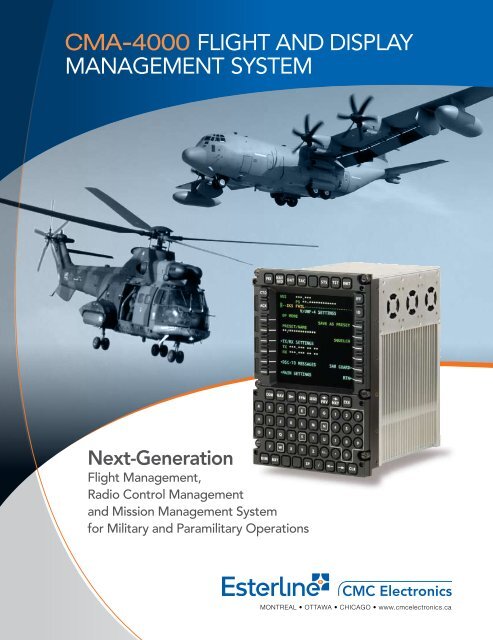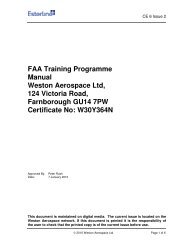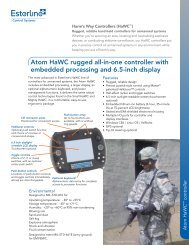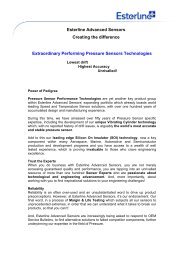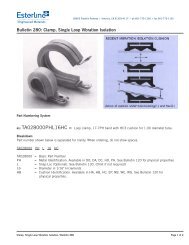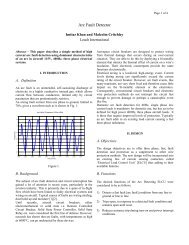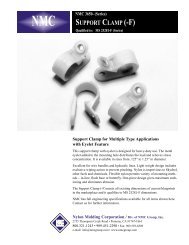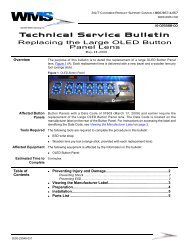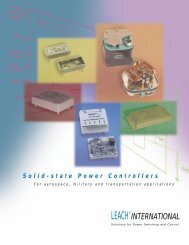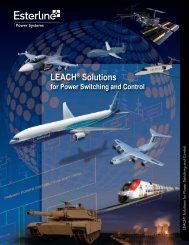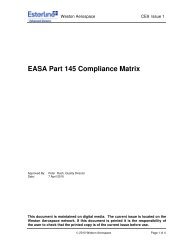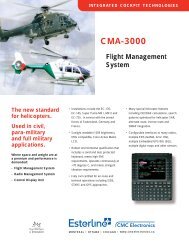cma-4000 flight and display management system - Esterline
cma-4000 flight and display management system - Esterline
cma-4000 flight and display management system - Esterline
You also want an ePaper? Increase the reach of your titles
YUMPU automatically turns print PDFs into web optimized ePapers that Google loves.
CMA-<strong>4000</strong> Flight <strong>and</strong> Display<br />
Management System<br />
Next-Generation<br />
Flight Management,<br />
Radio Control Management<br />
<strong>and</strong> Mission Management System<br />
for Military <strong>and</strong> Paramilitary Operations<br />
MONTREAL • OTTAWA • CHICAGO • www.cmcelectronics.ca
CMA-<strong>4000</strong><br />
The CMA-<strong>4000</strong> is the next generation of Flight <strong>and</strong> Display<br />
Management System (FDMS) designed for rotary <strong>and</strong> fixed<br />
wing mission <strong>system</strong>s. It comprises Flight Management,<br />
Radio Control Management <strong>and</strong> Mission Management Systems<br />
(FMS / RMS / MMS) in a single box. The combination of<br />
civil <strong>flight</strong> plans, with multiple type search patterns, radio<br />
control <strong>and</strong> control of mission specific equipment makes<br />
the CMA-<strong>4000</strong> FDMS the product of choice for military <strong>and</strong><br />
paramilitary operations.<br />
• Operational advantages while operating in civil airspace<br />
resulting in lower costs, l<strong>and</strong>ing clearances <strong>and</strong> preferential<br />
departures.<br />
• Mission effectiveness enhanced through centralized<br />
<strong>management</strong>. Mission data is easily transferred via data<br />
cartridge, <strong>and</strong> control <strong>and</strong> <strong>display</strong> of mission sensors by<br />
the FDMS increases situational awareness.<br />
• Inclusion of Radio Management, Flight Management <strong>and</strong><br />
Mission Management in a single lightweight box provides<br />
savings in weight <strong>and</strong> space.<br />
• Multiple search patterns <strong>and</strong> other capabilities increase the<br />
operational effectiveness of the aircraft <strong>and</strong> further reduce<br />
pilot workload.<br />
• Proven interfaces with many avionics equipments, with<br />
modern day processors, comprehensive memory <strong>and</strong> I/O,<br />
allow for ease of integration <strong>and</strong> long term growth.<br />
• Third party specialized software inclusion through<br />
additional processors or partitioned software.<br />
• Third party software development.<br />
Capabilities<br />
The CMA-<strong>4000</strong> provides radio <strong>management</strong>, mission control,<br />
<strong>flight</strong> <strong>management</strong> <strong>and</strong> seamless navigation throughout all<br />
phases of <strong>flight</strong>, including en-route, terminal, approach <strong>and</strong><br />
the mission phases of <strong>flight</strong>. Its ability to interface with a<br />
wide variety of navigation sensors <strong>and</strong> radios makes it very<br />
versatile for a wide variety of applications. Navigational<br />
solutions can be obtained via blended INS/GPS, GPS, INS,<br />
DME/DME. VOR/DME, VOR/DME/TACAN , DOPPLER <strong>and</strong><br />
Dead Reckoning. Frequency ranges for controlled radios are<br />
from HF, VHF, UHF, <strong>and</strong> SATCOM.<br />
Flight Management features<br />
• Extensive <strong>flight</strong> planning <strong>and</strong> route creation, second route<br />
modification.<br />
• SIDS, STARS, Direct to, Direct to with moving desired track<br />
<strong>and</strong> leg/course interception, holding patterns, DME arcs,<br />
procedure turns <strong>and</strong> offset tracks.<br />
• Multi-sensor navigation modes with installed navigation<br />
sensors <strong>and</strong> radios.<br />
• Search <strong>and</strong> Rescue pattern definition <strong>and</strong> navigation.<br />
• Required <strong>and</strong> actual navigation performance (RNP/ANP).<br />
• Time <strong>and</strong> fuel <strong>management</strong> including required time of<br />
arrival (RTA).<br />
• Ability to accept tactical <strong>flight</strong> plans from an external<br />
mission computer.<br />
• Optional video outputs to drive 2 MFDs with video inputs<br />
to overlay video to MFD.<br />
• RS-422 <strong>and</strong> Ethernet Airborne Data Loading (ADL)<br />
capability for database upload <strong>and</strong> download.<br />
FUNCTIONS<br />
Fuel Management<br />
RTA<br />
Transition to Hover<br />
Route Planning<br />
The CMA-<strong>4000</strong> computes<br />
<strong>and</strong> <strong>display</strong>s the maximum<br />
endurance, maximum<br />
range, fuel mileage <strong>and</strong><br />
fuel remaining over any<br />
defined way point at the<br />
<strong>display</strong>ed fuel rate.<br />
The CMA-<strong>4000</strong> is able to<br />
compute Required Time of<br />
Arrival (RTA) by estimating<br />
the necessary True Air<br />
Speed (TAS) required to<br />
achieve a RTA assigned to<br />
any down-track way point.<br />
The CMA-<strong>4000</strong> is able to<br />
manage a transdown profile<br />
to multiple hovers based<br />
on a mark point, a track at<br />
the mark point opposite<br />
to a wind direction or an<br />
operator entered course,<br />
<strong>and</strong> a hover height at the<br />
mark point.<br />
Comprehensive route<br />
planning available from<br />
either pre-stored data<br />
or manually entered.<br />
Active <strong>and</strong> st<strong>and</strong>by routes<br />
available.
Tactical features<br />
Comprehensive tactical features have been included in the<br />
CMA-<strong>4000</strong> to enhance the operational efficiency of the crew.<br />
Tactical features include:<br />
• 5 Search <strong>and</strong> Rescue patterns (Creeping Line, Exp<strong>and</strong>ing<br />
Square, Parallel Track, Sector Search <strong>and</strong> Track Crawl)<br />
specifically engineered to speed up the operation of<br />
finding people in the water during SAR <strong>and</strong> CSAR<br />
operations.<br />
• The Transition to Hover facility allows up to five hovers<br />
to be included in one <strong>flight</strong> plan, allowing such features<br />
as Dip-to-Dip functionality. The hover algorithms allow<br />
for into wind hover or operator defined course into hover,<br />
taking into account wind speed <strong>and</strong> direction to enable<br />
a pilot to quickly find <strong>and</strong> transition onto a casualty in<br />
adverse weather <strong>and</strong> sea conditions.<br />
• Tactical communications interface including SATCOM,<br />
LINK11, Radio Relay <strong>and</strong> HVQK.<br />
• The FDMS can act as a mission controller, providing<br />
essential mission capabilities such as search <strong>and</strong><br />
weather radar control, IFF Interrogator control as well<br />
as control over self-defence suites.<br />
Radio Management<br />
The CMA-<strong>4000</strong> provides centralized <strong>management</strong> <strong>and</strong><br />
control of navigation <strong>and</strong> communication radios, including:<br />
• DME, ADF, VOR/ILS, VHF-AM/FM, UHF, HF, SATCOM, DF PLS<br />
(personal locator <strong>system</strong>).<br />
• Radio presets for each radio can be loaded from an external<br />
mission data cartridge allowing for ease of cockpit radio<br />
control <strong>and</strong> reducing pilot workload.<br />
• Various mode controls for different radios (Manual, Maritime,<br />
Four Channel Scan, HVQK, SATCOM, ALE, Buoy Mode,<br />
SAR SCAN, TAC SCAN, LINK11, DICASS programming).<br />
• Extensive Human Factors (HFE) work to ensure all radio<br />
controls have similar look <strong>and</strong> feel to ease pilot training<br />
<strong>and</strong> workload.<br />
• Numerous civilian <strong>and</strong> military radios have been integrated<br />
in the CMA-<strong>4000</strong>, over Serial, ARINC-429 <strong>and</strong> MIL-STD-1553<br />
interfaces (details provided on request).<br />
S.A.R.<br />
Mission Systems<br />
Radio Management<br />
Databases<br />
The CMA-<strong>4000</strong> is able to<br />
provide a search pattern<br />
function comprising<br />
exp<strong>and</strong>ing square, creeping<br />
line, parallel track, track crawl<br />
<strong>and</strong> sector search. A search<br />
pattern may be defined at<br />
any en-route way point.<br />
The CMS-<strong>4000</strong> can interface<br />
with multiple mission<br />
<strong>system</strong>s to enable crew<br />
to have better situational<br />
awareness. These include<br />
self-defence suites, IFF<br />
Interrogator, <strong>and</strong> Search <strong>and</strong><br />
Weather Radar controls.<br />
The CMA-<strong>4000</strong> can remotely<br />
tune <strong>and</strong> control both Nav<br />
<strong>and</strong> Communication radios<br />
over multiple b<strong>and</strong>s, with<br />
multiple mode controls.<br />
The CMA-<strong>4000</strong> is equipped<br />
to store several types of<br />
Civilian, Custom <strong>and</strong> User<br />
definable databases. Large<br />
memory space available.<br />
Databases updated<br />
via Ethernet or RS-422<br />
Dataloader.
CMA-<strong>4000</strong> FLIGHT AND DISPLAY MANAGEMENT SYSTEM (FDMS) – CHARACTERISTICS<br />
A compact, low weight CDU/FMS, Mission Computer <strong>and</strong> Display Management System.<br />
FeAtUreS<br />
Compact PCi/PMC Open<br />
Architecture<br />
Multiple Processor Support<br />
Solid State Mass Memory Card<br />
LeD Backlight<br />
BeneFitS<br />
Enhanced obsolescence <strong>management</strong><br />
Exceptional growth <strong>and</strong> upgrade capabilities including third party customer modules<br />
Separate operational <strong>flight</strong> programs/applications, with hardware <strong>and</strong> software partitioning, possible<br />
Map, navigation database, terrain database storage <strong>and</strong> <strong>management</strong> (optional)<br />
High reliability <strong>and</strong> high brightness for sunlight readability<br />
SPeCiFiCAtiOnS FOr BASiC COnFiGUrAtiOn<br />
(One each processor <strong>and</strong> graphics carrier cards) PMC module on processor card. One IO Assembly. Two spare 3U cPCI card slots for growth<br />
GenerAL<br />
Size<br />
Weight<br />
Power input<br />
Cooling<br />
Connectors<br />
Mounting<br />
DiSPLAy<br />
type<br />
resolution<br />
Active Display Size<br />
Viewing Angle<br />
Chassis only, from rear of mounting plate to rear panel: 5.0”W x 8.25”H x 6.8” D<br />
Height may be extended beyond chassis to accomodate a larger keypanel<br />
11 lb (nominal) configuration dependant<br />
+28 Vdc per MIL-STD-704A, MIL-STD-810E <strong>and</strong> RTCA/DO-160D, max 120 W at full <strong>display</strong> luminance<br />
A combination of conduction, convection <strong>and</strong> self-contained fans. No forced air cooling required<br />
MIL-C-38999 providing up to 284 pins<br />
DZUS rail<br />
TFT color LCD with LED backlight<br />
VGA<br />
4” x 4” or 5” x 3”, dependant upon keyboard selection.<br />
Exp<strong>and</strong>able to 4” x 5”<br />
Vertical: ± 35 degrees<br />
Horizontal: ± 60 degrees<br />
RGB with 64 grey shades per color<br />
MIL-STD-3009, Class B, Type I/II multicolor <strong>display</strong>s<br />
Full luminance capability up to 300 fL<br />
Color<br />
nVG Compatibility<br />
Luminance<br />
Contrast ratio 300:1<br />
KeyBOArD (The following describes an existing full alphanumeric keyboard)<br />
Keys<br />
Annunciators<br />
integral Lighting<br />
nVG Compatibility<br />
interFACe CAPABiLity<br />
St<strong>and</strong>ard<br />
PrOCeSSOr/SOFtWAre<br />
10 soft, 65 independent alphanumeric, 2 rocker<br />
4 LED, NVG compatible<br />
5Vac/dc, LED, NVG compatible, external supply<br />
MIL-STD-3009, Type 1, Class-A-NVIS<br />
Qty 2 10/100BaseT Ethernet<br />
Qty 2 Dual redundant MIL-STD-1553B interface with independent RT addressing<br />
Qty 1 RS-232 port<br />
Qty 12 ARINC-429 receivers (exp<strong>and</strong>able to qty 16 if spare cPCI card slot is used)<br />
Qty 8 ARINC transmitters (qty 10 if spare cPCI card slot is used, qty 12 with modification to interconnect)<br />
Qty 4 RS-44/485/232 transceivers<br />
Qty 36 discrete inputs <strong>and</strong> qty 16 discrete outputs<br />
Qty 2 video composite/S-video inputs (qty 4 if auxiliary Graphics Carrier card is installed in spare slot)<br />
Qty 2 RGB video outputs (optional)<br />
Qty 1 KY-58 interface<br />
Qty 2 SPDT relay outputs<br />
Qty 1 <strong>system</strong> JTAG chain for test <strong>and</strong> configuration<br />
Processor St<strong>and</strong>ard 500 MHz PowerPC G4, 512K NVRAM, 256M RAM, 4 Gbyte Flash<br />
Optional Any PowerPC PMC processor<br />
Operating System<br />
VxWorks, Green Hills Integrity 178B<br />
Symbol Generation (optional) Raster (RGB, DVI or LVDS)<br />
Graphics Driver (optional)<br />
OpenGL<br />
enVirOnMent<br />
MIL-STD-810E <strong>and</strong> RTCA/DO-160D<br />
eMi/eMC<br />
MIL-STD-461D <strong>and</strong> RTCA/DO-160D<br />
GrOWth CAPABiLity<br />
Two 3U cPCI card slots together with PMC available for growth<br />
415 Legget Drive,<br />
P.O. Box 13330, Ottawa,<br />
Ontario, Canada K2K 2B2<br />
Tel.: (613) 592-6500<br />
Fax: (613) 592-7427<br />
www.cmcelectronics.ca<br />
For information purposes only. To accommodate product improvements, specifications are subject to change without notice.<br />
CMC CMA-<strong>4000</strong> FDMS 4-p 09/10 PRINTED IN CANADA


